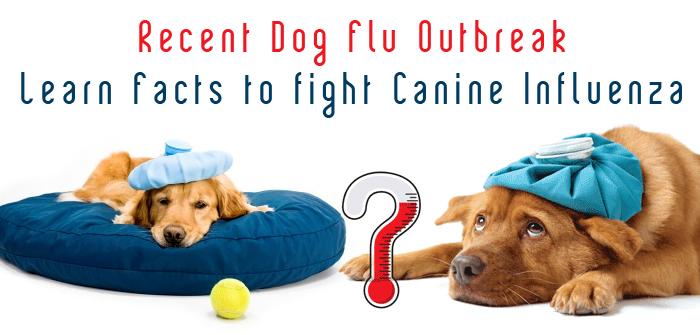Recent Dog Flu Outbreak- Learn Facts to fight Canine Influenza

CBS news has recently reported about dog flu spreading through western states and the health officials in the Seattle have confirmed that 80-90 dogs are tested positive for respiratory illness. Canine influenza had begun in last spring in Chicago and had taken almost 1000 dog lives then.
Although this outbreak has not spread like it did the previous year, yet there is no harm in knowing everything about it to protect your canines. Keep your pooches safe and consult your vet immediately if you observe any kind of illness in them. Here are some facts that may help you know and fight canine influenza better.
What is canine influenza?
Canine influenza is a respiratory disease spread through H3N8 and H3N2 virus. H3N2 is the one that spread across almost 25 states in 2015 and has been reported recently in western states. H3n2 is highly contagious and its symptoms may vary from respiratory issues to no signs. This dog flu needs immediate veterinary attention and it is better to prevent it rather than curing.
What are the main symptoms of H3N2?
Detecting H3N2 is a bit difficult as the symptoms are of general fever. In some cases, dogs may even seem alright and have a sudden collapse in health. However, there are some symptoms on occurrence of which your pooch may need immediate veterinary assistance. Check for:
- Loss of appetite
- Coughing
- Lethargy
- Sneezing
- Issues in breathing
- Water-like nasal discharge that changes to thick green mucus with time
- Pneumonia
Pets may also acquire pneumonia without showing the initial symptoms of sickness which is why it is recommended to prevent the flu. If you pooch has caught cough or cold then immediately isolate him/her from your other pets.
How to protect your dogs from getting H3N2?
H3N8 and H3N2 both are highly contagious and may catch your pooch through air around the infected pet. Here are some of the tips on how to safeguard your pup from dog flu:
- Observation is the prime key of flu prevention in dogs. Do not let your canine mingle with any other canine that is sick or having respiratory issues. Keep a safe distance from suspects during walk or at home if you have more than one pooch.
- Keep all the symptoms in mind and observe your pet closely for a few weeks. Keep your pet’s medical records on hand and treat smaller issues like cough or sneezing immediately.
- Keep your fido on nutritional diet as higher immunity may not let your pooch get trapped by H3N2.
- Contact your veterinarian or browse for effective dog supplies and healing products as soon as you think your pet is having respiratory issues or is catching cold. Ignoring these primary signs may leave your pet with Pneumonia.
Though H3N2 flu has not been detected in all states, it is better to take precautionary steps. Stay vigilant and take the right decisions to avoid illness take a toll on your furry friend.

